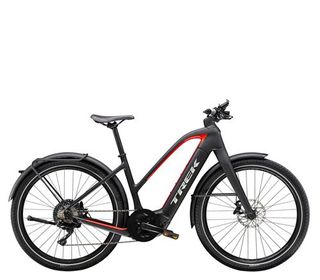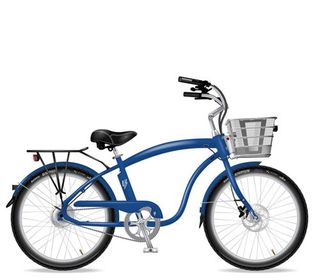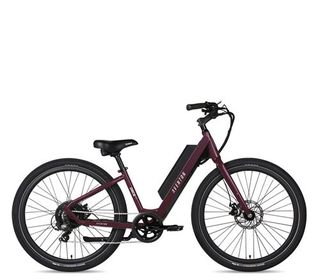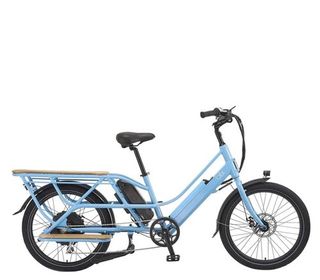Drawing and the Art of Bcucling Riding
Pete Stokes really didn't expect to go viral when he embarked on an eight-and-a-half-hour ride on his singlespeed bike earlier this month. He was just excited to follow his new route: 150 kilometers around Adelaide, Australia—a route designed to recreate Nirvana's swimming baby album cover in GPS doodle form.
Why spend a day recreating an album cover by bike? Well, because it's the 30th anniversary of Nevermind—Nirvana's album featuring that baby art—and Stokes loves linking his Strava artwork to important dates in the cultural zeitgeist... Though he's also not above spending a day making an intricate dragon design just for fun.
Here, we chatted with Stokes, avid off-road cyclist and national parks project manager, about how he comes up with ideas for designs and makes them happen, using city streets (and the occasional Ferris Bueller-style cut through) as his canvas.
Get the Family Involved
You'd be amazed at what kids can see when they look at a map! "I started doing these Strava drawings as a thing for my kids to do during the school holidays," Stokes says. "I printed out this map of Adelaide and I said to my kids, 'Take a pen and draw a rabbit by following the roads—and you're not allowed to take a pen off the paper. I went and rode it, and I admit, it was pretty crappy, but it was cute. That's how it started for me, though obviously I built on it quite a bit from there."
Pick the Right Images
"I absolutely did not expect the Nirvana cover GPS to go viral. But I try to do things that resonate with the time," Stokes admits. "I did a portrait of Beethoven last year for his 250th birthday, for example. I'm not looking for mad virality or anything, though. I guess it was just the right thing at the right time and people jumped on it."
Design for the Art, Not the Roads
"A lot of people design by looking at a roadmap, and they see shapes in that. I really admire that method, but that's not how I do my designs. I don't have that particular skill. I decide what I want to do, then I get a line drawing of that image, and overlay it on a map and resize and move it until I find a way to make it work," Stokes say.
"It's two opposite ways of doing it. For someone who can look at roads and decide on an image based on them, I feel it's a bit like a wood carving, where you've got this piece of wood and you can see something in it," he adds. "But for me, it's more like modeling with clay where you can just add on whatever you need to make it work."
Ride Roads as Needed
"Riding on the road is definitely not my comfort zone or my preferred place to be, but that's where the canvas is," he says. "The trails are a lot harder to use. They're very defined in their shapes already, so it's hard to design around them. Cities tend to offer more of a grid. That said, being able to go off-road to do a drawing is really helpful: There have definitely been times where I've shortcut across green space or used trails when they do happen to work for a drawing."
Pause GPS for Detours
"When I was making the dragon design, I got a massive flat that I just could not fix halfway through. I had to pause my GPS and walk five kilometers to a bike shop to get it fixed—that was a long day!" Stokes recalls. But when you're spending 5+ hours on a design, you don't want to give up partway through. So do what you have to do, then keep riding.
Don't Stress Small Stuff
If you take a wrong turn and realize it quickly, don't panic that your design is ruined. Because most cycling Strava GPS artwork requires 40+ miles of riding, the tiny details won't matter in the overall aesthetic.
"I don't often get routes wrong, but if you really zoom in and go into detail with my routes, you can see where I have gone 50 extra meters down a road before catching it and making a U-turn," Stokes admits. "But when you look at it as a whole, you usually can't tell." (Still, he admits to being pretty stressed in the final miles of a ride, especially a long one! Who wants to mess up all that work?)
Create a Design Process
Stokes uses an imaging program to take a line drawing and overlay it on a city map. (While he uses a program from his work, you can do the same with layers in Photoshop or an online tool like Pixlr relatively easily.) He drops a transparent line drawing over the map of Adelaide, then plays with size and location until he finds a close match using roads. "That's what I would call my first draft," he says.
Then, he moves into a mapping tool to create the GPX file that he'll follow. "I make sure that the draft is actually based on real roads—retirement homes and gated communities have been a problem because they show up as roads but you can't ride them. Using Google Street Google Street View is really helpful here." Once he has a file he's happy with, Stokes uploads it to his phone, which he uses for navigation on a handlebar mount.
Expect Obstacles
"I've gotten pretty adept at jumping over fences," Stokes says. "The most recent one was probably two meters high, with stakes on the top. I managed to lift my bike over and hook it on the fence by the handlebars and then haul myself up and over, desperately trying not to get my Lycra caught on the stakes. Then I was down and on my merry way!" He does note that some designs he's tried have been wrecked by obstacles that he was unable to navigate over or around. Don't be surprised (or upset!) if that happens to you.
Bring a Backup GPS
Stokes uses a GPS watch to record his rides, but keeps an eye on the battery and occasionally turns on the Strava app on his phone for backup. "Normally I just use my phone for navigation and music, though," he says. "I definitely listened to Nirvana for a lot of that last ride!"
Be Careful
"It's easy to get caught up in navigation and trying to make your drawing perfect," Stokes says. "But it's important to remember that you need to be careful when you're riding around and doing one of these designs. Road safety is still important!" In fact, road safety might be even more relevant in these situations, because you're often making turns that you wouldn't make on a normal ride, plus you're trying to focus on directions closely. So be careful while you're out there!
For more tips on creating the perfect Strava masterpiece, we also enlisted Stephen Lund, creator of GPSdoodles.com, to share some of his top tips:
Know the Route is King
Before he sets out, Lund meticulously pre-maps his route to get his design perfect. To start a design, Lund finds it most helpful to highlight the main thoroughfares in an area on a map (on paper or in Photoshop) and then stand back and look for ready-made shapes.
He adds that unfortunately, maps don't always account for roadwork and detours (or as Stokes says, communities that don't allow you to bike around), and even a minor route change can throw off a drawing. Using Google Maps to design a route and then uploading it to a GPS device is a great way to prepare.
Work With What You've Got
Even rural cyclists can use rolling, curving landscapes to create cool stuff, though they might have to look harder at maps to create cool routes. "Anywhere you are, there's creative potential," Lund says. Zoom in and out of an area on Google Maps, look for cool lines and shapes (or have a rough idea of a word or shape to create), and then look for roads that will match it.

Stephen Lund/Strava
Start With Words
"My first was a Happy New Year sign on Strava," Lund says. Words are easiest to create because they're fairly straightforward, he explains, and you can—if you plan carefully—simply pause Strava for a few yards in order to create a space between each letter. Words are particularly easy, Lund adds, if you live in a neatly gridded city.
Anticipate an Increase in Mileage
"Doing Strava art the past seven months has gotten me to do 4,000 kilometers of riding that I wouldn't have otherwise done," Lund says. He adds that having a purpose for his rides has added a new element of fun to them, and now he can't wait to get back home to upload his files to see if his designs worked out.
And Plan to Be Out for a While
"Most of the pieces take about 70 kilometers to do," Lund says. Budget for extra time on Strava art rides, since following a route perfectly is key to a flawless design, and you'll likely need to stop to ponder your route map at least once or twice. He also adds that he occasionally has restarted a ride after a wrong turn, and that mileage definitely adds up!
Don't Be Cliché
"I hear a lot about people drawing penises," Lund says. "It seems weirdly popular. And maybe I would do that one day, but it would be on a statue of David, to give it some context." Be original with your artwork.
Make Large Scale Your Friend
Especially for new Strava artists, focusing on a bigger picture will make mistakes less visible on the overall map. If you're in a city and focused on a small range of city blocks, each misstep will be ultra-apparent—but if you create a cool shape from a 100-mile journey, even if you made a minor error, it won't be as obvious on the overall map.
Go Off-Road to Connect the Dots
"I use a lot of off-road improvisation," Lund says. He'll occasionally use trails, stairwells, and even open fields to create the perfect image when the roads aren't cooperating. "It's that urban exploration that makes it fun," he adds. It's about the art of adventure, and it helps you get better acquainted with the area you live in—you might find some great backroads in the pursuit of art!
Stay Positive
If you miss a turn or get tripped up on your route, your drawing might be ruined that day, but you can always try again tomorrow. "It can be demoralizing at times," Lund explains, when you've spent a day on a careful artistic route only to find an early wrong turn derailed your drawing. "There's no eraser, so you've got to pay closer attention in rides," he adds. There is a silver lining to being hyper-aware, though: That attention to the route can actually bring a new element of focus to your rides. And that means you'll be even more prepared for tomorrow's artistic ride.
The 4 Best E-Bikes You Can Buy Right Now

No-Nonsense Commuter
Allant+ 9.9S
High-speed, all-carbon commuter.

Customizable Cruiser
Model X
Electric Bike Company
$1,949.00
Order online, arrives fully assembled.

Best Value E-Bike
Pace 350
Cheap and reliable step-through.

Best Value Cargo
Packa
Affordable mid-tail with 70-mile range.
This content is created and maintained by a third party, and imported onto this page to help users provide their email addresses. You may be able to find more information about this and similar content at piano.io
Drawing and the Art of Bcucling Riding
Source: https://www.bicycling.com/rides/a20044377/become-a-strava-artist-with-these-gps-tips/
0 Response to "Drawing and the Art of Bcucling Riding"
Post a Comment